Key takeaways:
- Open communication fosters team collaboration and innovation, allowing diverse voices to contribute effectively.
- Gender equality enhances team dynamics and economic growth by providing varied perspectives and solutions.
- Regular check-ins and mentorship programs promote inclusivity and strengthen team relationships.
- Measuring success involves qualitative feedback and observing team dynamics to identify areas for growth.

Understanding team dynamics
When I think about team dynamics, I often reflect on my own experiences working in diverse groups. I’ve noticed how each person brings their unique background, perspectives, and strengths to the table. It makes me wonder: how well are we leveraging these differences to enhance team collaboration?
In my previous projects, I found that open communication played a pivotal role in shaping our team dynamics. I remember a time when a quiet team member shared a brilliant idea that transformed our approach. It struck me that when we create an environment where everyone feels safe to express themselves, we not only boost morale but also unlock the potential for innovation.
Another fascinating aspect of team dynamics is how conflicts can actually serve as catalysts for growth. I once faced a disagreement with a colleague over the best strategy for an advocacy campaign. Initially, it felt uncomfortable, but once we navigated through it, we emerged with a stronger, more unified vision. I often ask myself: how can we reframe conflicts as opportunities rather than setbacks?
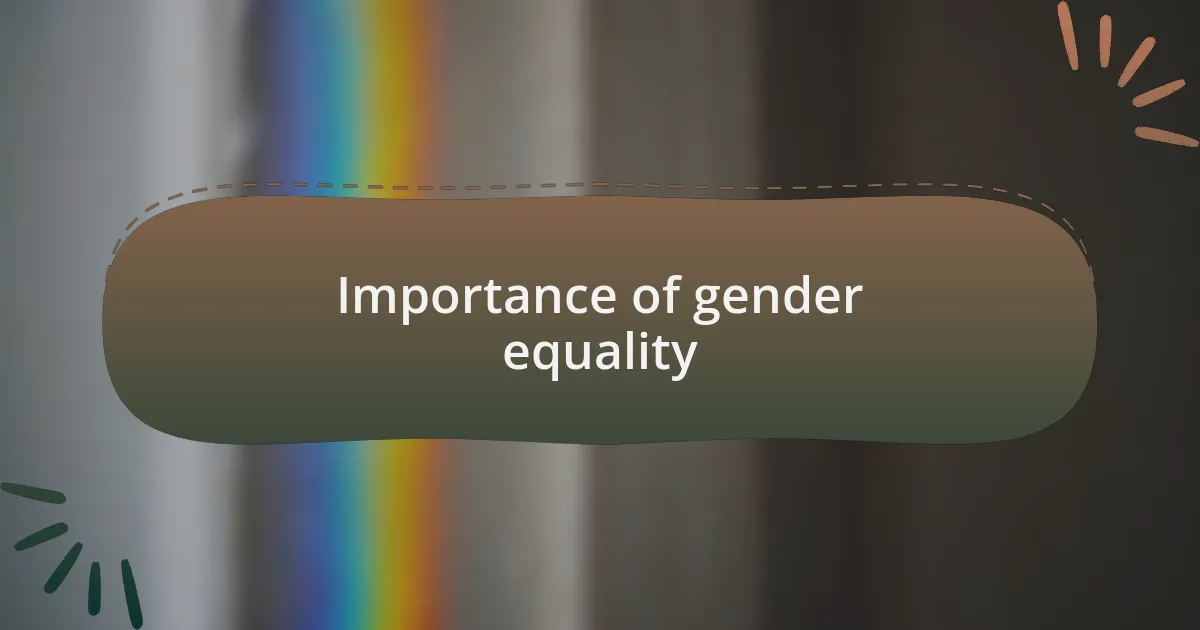
Importance of gender equality
Gender equality is essential for fostering a just and equitable society. I’ve witnessed firsthand how inclusive environments can positively impact team morale and productivity. In one of my previous roles, a balanced representation of genders not only sparked creativity but also led to more comprehensive solutions. It makes me think: how can we continue pushing for environments where everyone feels valued?
When all voices are heard and respected, it drives engagement and innovation. I recall a situation where our mixed-gender team tackled a particularly challenging problem. The variety of perspectives brought forward allowed us to analyze the issue from multiple angles, leading to a well-rounded and effective strategy. Isn’t it fascinating how diversity in thought—rooted in gender equality—can reshape our approaches to problem-solving?
Moreover, gender equality significantly influences economic development. Research shows that increasing women’s participation in the workforce can boost GDP by substantial margins. I often reflect on how empowering women not only benefits families but also stimulates wider community growth. How can we overlook such a powerful driver for societal advancement?
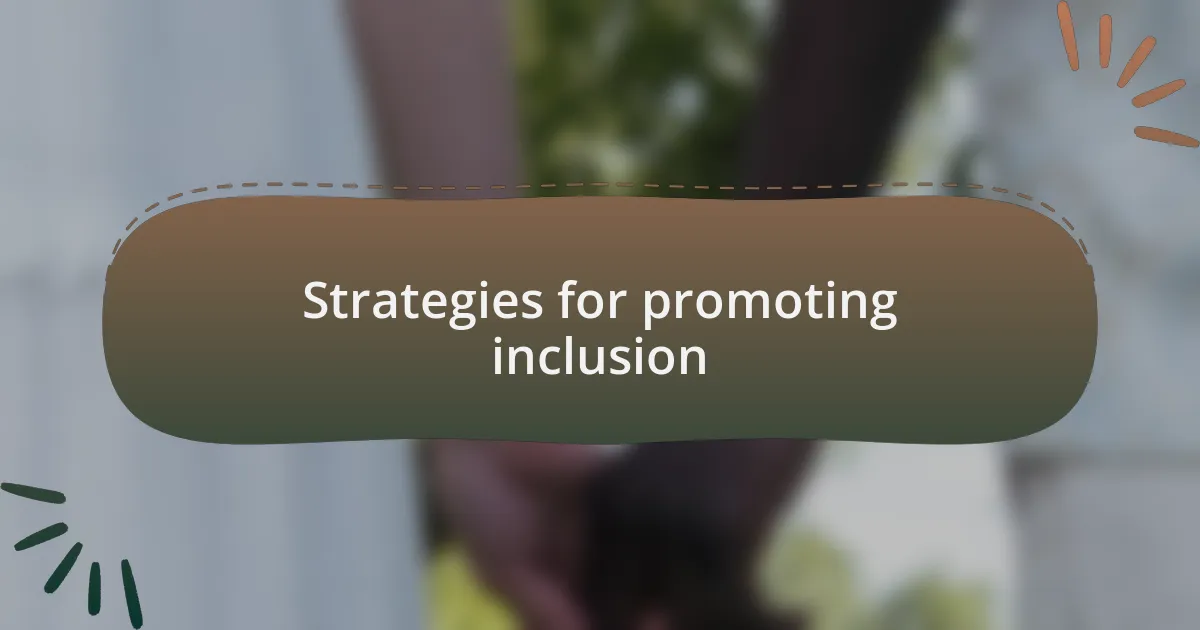
Strategies for promoting inclusion
Fostering an inclusive atmosphere can begin with small, intentional strategies. I remember a former colleague who proposed weekly team check-ins that prioritized open dialogue. These sessions weren’t just about project status; they became a platform for each person to share ideas or concerns, creating a stronger sense of belonging and collaboration among us. How simple gestures, like ensuring everyone has a voice, can lead to profound shifts in team dynamic!
Another effective approach I’ve witnessed involves mentoring and sponsorship programs that connect underrepresented genders with experienced leaders. On one occasion, I took on a mentorship role that spurred not only my mentee’s confidence but also enriched my perspective on leadership styles. This exchange fostered growth for both of us—how powerful it is to uplift others while broadening your own horizons!
Lastly, I’ve seen the impact of inclusive policies that accommodate diverse needs, such as flexible working hours to support family commitments. In my experience, when a company actively demonstrates that it values personal lives alongside work, I noticed morale boost considerably. It raises the question: can flexibility not only accommodate differences but also empower individuals to fully engage and innovate in their roles?
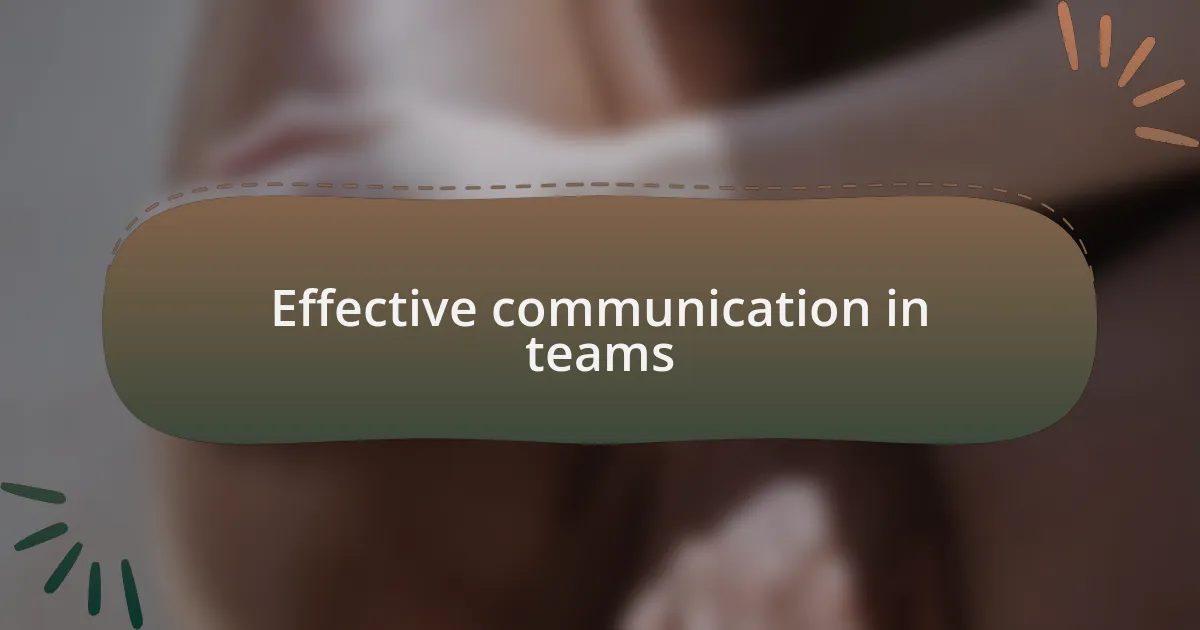
Effective communication in teams
When I think about effective communication in teams, I recall a project where we established a shared digital platform for collaboration. This not only streamlined our discussions, but also allowed everyone, regardless of their position or background, to contribute asynchronously. I often found myself refreshing the platform, excited to see new ideas pop up. It made me realize how vital it is that every voice is included, fostering creativity and respect.
In another instance, I was part of a team where we practiced active listening—wherein team members were encouraged to repeat back what they heard before responding. Initially, it felt awkward, but over time, it built a culture of understanding. I could sense the transformation in the team’s trust and cohesion. Isn’t it fascinating how a slight shift in our communication approach can make us feel more connected and valued?
Moreover, I believe transparency plays a crucial role in communication dynamics. During a particularly challenging project, our leader shared both the successes and setbacks openly. This honesty not only kept morale high but also encouraged us to bring our concerns forward without fear of backlash. Have you noticed how leaders who embrace vulnerability create a safer space for dialogue? It’s remarkable how this sense of openness can propel a team towards greater resilience and unity.
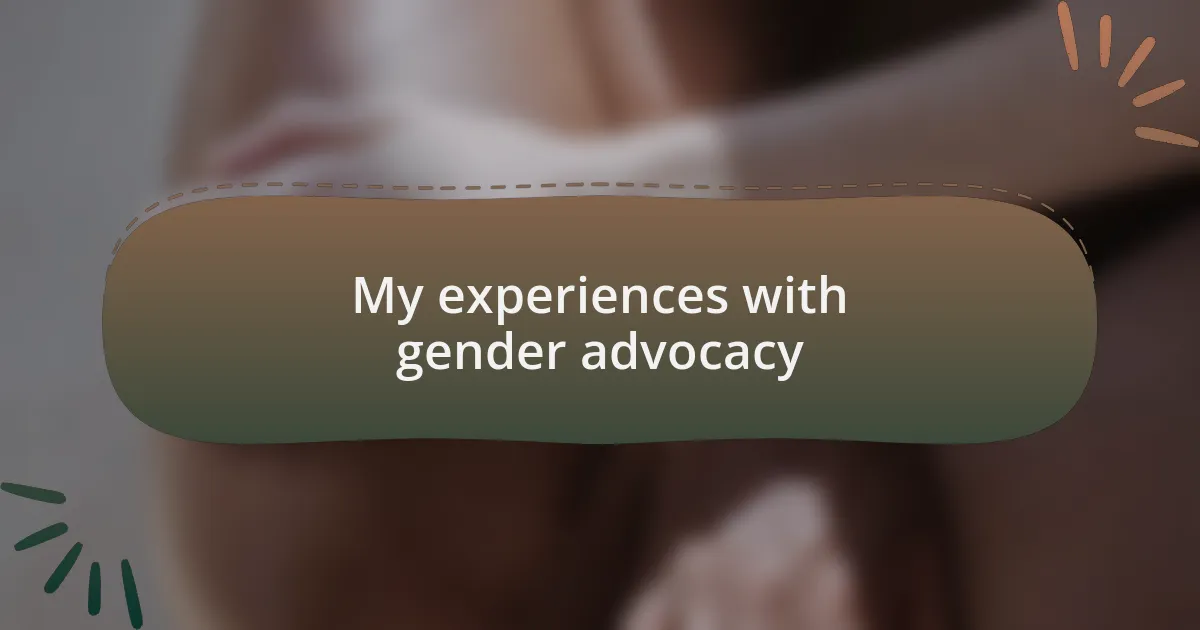
My experiences with gender advocacy
My experiences with gender advocacy have been profoundly impactful and often deeply personal. I remember attending my first women’s rights rally, feeling a mix of nervousness and determination. Standing among people who shared my passion was a transformative moment for me. It sparked a fire in my heart, making me realize that advocating for gender equality isn’t just about improving the system; it’s about uplifting voices we often overlook.
In my workplace, I initiated a mentorship program focused on women in leadership. What surprised me was how much I learned from the participants. Their stories of overcoming barriers resonated with my own struggles and opened my eyes to the unique challenges they face. It’s incredible to think about how shared experiences can create bonds that inspire change, don’t you think? That collaborative spirit ignited a collective ambition within us, encouraging everyone to aim higher.
Another memorable experience was when I organized a workshop on gender bias. The reactions were profound—some individuals were shocked by their unconscious biases, while others felt relieved to discuss topics that had been previously avoided. I witnessed how important it is to create safe spaces for these dialogues. Have you ever considered how awareness can lead to action? It’s moments like these that remind me that advocacy is not just about addressing problems—it’s about fostering understanding and encouraging others to join the cause.
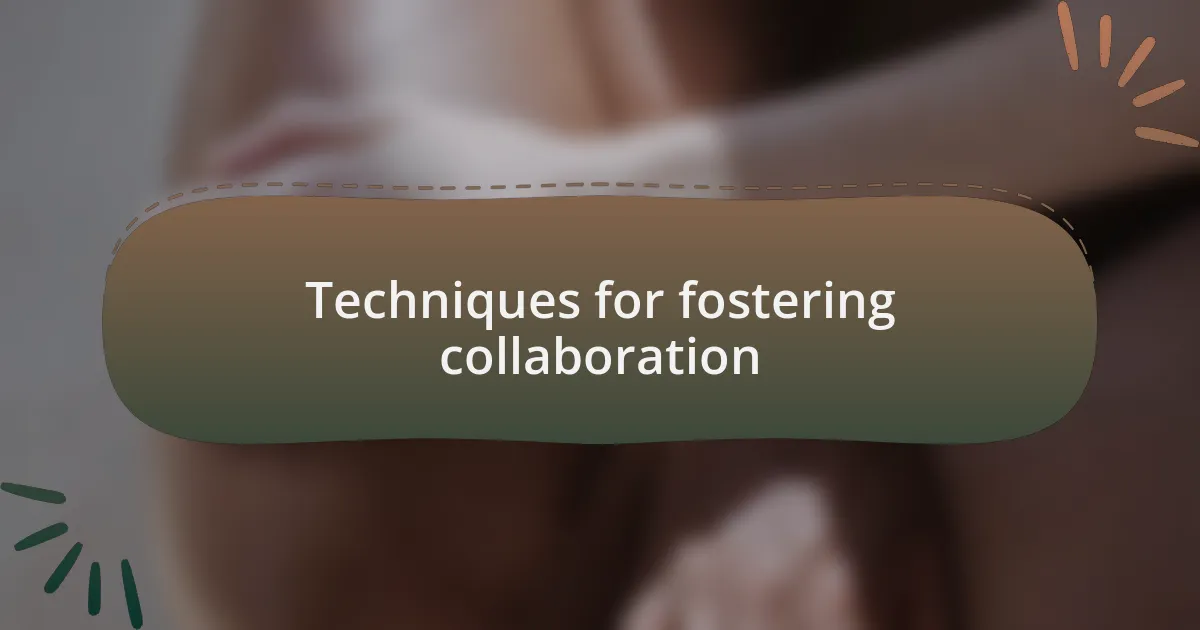
Techniques for fostering collaboration
One technique I’ve found to be effective in fostering collaboration is establishing clear communication norms within the team. I remember a project where we had weekly check-ins, allowing everyone to voice their thoughts and concerns. This routine not only kept us accountable but also transformed our meetings into open forums where creative ideas could flow freely. How can a simple check-in change the energy of a group? It can make people feel valued and heard, encouraging active participation.
Another strategy is the incorporation of team-building activities that align with our advocacy goals. I once facilitated an event where we collaborated on community art projects focused on gender equality. Watching team members connect over shared creative expressions was powerful. Have you ever seen how art can bridge gaps in understanding? It not only reinforced our mission but also built trust among us, strengthening our collaboration.
I also believe in recognizing and celebrating each team member’s contributions, regardless of their role. During a recent initiative, I started a monthly shout-out session where we honored different team members for their unique input. It was heartwarming to see how this simple acknowledgment uplifted spirits and motivated everyone. Isn’t it fascinating how a little recognition can fuel enthusiasm? It reminded me that fostering a collaborative environment isn’t just about teamwork; it’s about nurturing relationships and respect.
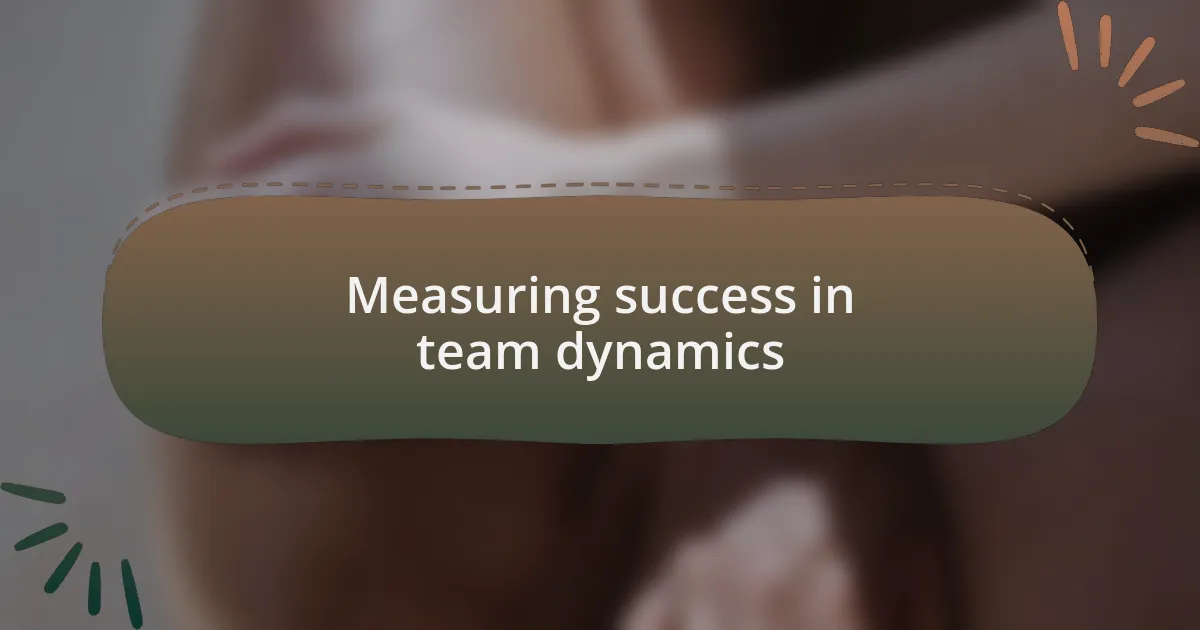
Measuring success in team dynamics
Measuring success in team dynamics often involves assessing both qualitative and quantitative factors. In my experience, a simple satisfaction survey after a collaborative project can provide valuable feedback. I recall a time when we distributed surveys that included open-ended questions about team interactions. The insights we gathered weren’t just numbers; they unveiled deeper sentiments about teamwork and highlighted areas where we excelled and where we needed growth. How do we know if teams feel connected? Sometimes, their words tell us more than metrics can.
Equally important is observing team dynamics during collaboration, which can be a key indicator of success. I once participated in a project that utilized a structured observation method, where we took notes on interactions and participation levels. This approach revealed so much about our group dynamics. It was fascinating to see how body language and engagement levels toggled—times when people leaned in with enthusiasm contrasted sharply with moments of disengagement. Isn’t it eye-opening to recognize how much communication happens beyond words?
Lastly, I advocate for regular reflection sessions after major milestones to measure our success in dynamics. After one influential campaign, we gathered to discuss our collaboration process openly. This meeting transformed into a safe space where we shared what worked and what didn’t, allowing each voice to resonate. Reflecting this way created a collective understanding of our progress and taught us invaluable lessons about adapting our strategies. Have you ever experienced an epiphany during a reflective discussion? Those moments can lead to significant improvements in how teams function together.